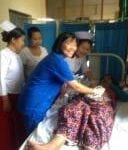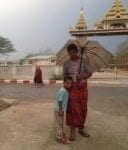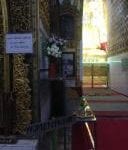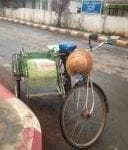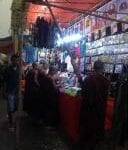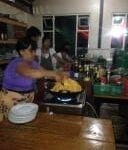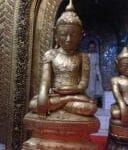Written by Thu Tran, MD,FACOG
April 24, 2014
Today we went to the clinic in Naung Shwe, Shan State. As with the other clinics, we arrived with the entourage of women from the Myanmar Maternal and Child Welfare Association (MMCWA), a powerful organization in Myanmar, an NGO (Non-Governmental Organization). The members of this group were almost all women and were mostly physicians themselves. I heard that many of them were married to powerful men in Myanmar. They were certainly the upper 1% of their country. We missionaries called them the “NGO ladies.” This organization funds many health projects throughout Myanmar. Like the day before, in the bare courtyard of red dirt with a few trees, hundreds of patients were waiting for our arrival. I thought I saw a Plumeria tree in full bloom. A group of women in lovely traditional costumes and colorful headpieces lined up to greet us.
Again, I had my own room as I needed an exam bed to perform pelvic exams. I was assigned two nurses and an interpreter. From the window of my exam room, I could see a little courtyard where a dog was resting lazily by a door. An elderly man with severe osteoporosis was walking back and forth with a water bucket in his hand. It seems as if people of all ages have to work here, doing their part of the labor to sustain their livelihood.
Shortly after the clinic started, a 31 year-old pregnant woman in a turmeric yellow dress entered my office with the chief complaint of edema in her extremities. She looked a little lethargic like most of the patients here, as if the hot sun has sucked up most of their energy. I had never seen such swollen feet! The edema extended uniformly throughout her lower extremities and it looked as if her knees and ankles had become a wide piece of shiny, dark ivory wood.
“Do you have a headache?”
I asked her as the interpreter looked on. She rubbed her forehead and nodded. Her skin was fairly dark and with the room brightened only by dim light from the small window. I couldn’t decide if I saw edema on her face or around her eyes. Peri-orbital edema is not a good sign in pregnancy. I immediately asked the nurse to check her blood pressure. It’s not automatic here that the vital signs are checked by nurses.
Her blood pressure was 150/110! Severe hypertension is when the blood pressure reaches 160/110.
We didn’t have a way to check her urine for protein, as the obstetrics clinic staff do not check their pregnant patients’ urine for sugar and protein on a routine basis. I sent her to Dr. Sophie Richard in the medical area to obtain a urinalysis. Her urine had 3+ protein. She had severe preeclampsia! She needed to have her baby delivered immediately! According to her expectant due date, she was 32 weeks pregnant. Her uterus, however, measured only 24 cm. meaning that most likely she had severe preeclampsia with fetal growth restriction, a very serious condition in pregnancy.
Her baby’s heart rate was normal and strong. How could I tell her to enjoy that moment, that it probably was the first and the last time for her to hear her first baby’s heart beat? The border of life and death in this area of Myanmar is very narrow. Even in the unlikely case that there is any sort of NICU here, it is highly improbable that this precious life will be saved. I saw the birth statistics in the Taunggyi Women’s Hospital where there was a NICU and the newborn death rate was still 29.9 %. How could I expect more in this more rural setting?
“She needs to go to the hospital now to have an emergency cesarean section!” I told the interpreter. As we Americans would say, the ball started rolling, with multiple people hollering in Burmese and the clinic doctor in charge loudly explaining the situation to the patient. The patient started crying quietly. There was an exchange of more words and more hollering before the medical officer, my interpreter, explained to me that the patient wanted to wait for her family before leaving for the hospital more than an hour and a half away. Don’t we all want to wait for our family? Who would want to be alone witnessing the birth and death of our first child?
Another interesting case was a 47 year-old patient with a history of cervicitis (cervical inflammation) which several years ago had led to a total abdominal hysterectomy and removal of both ovaries, a totally unnecessary procedure for her. What would I have done with her cervicitis? Probably nothing except for a yearly Pap smear. How did the surgeon explain why she needed the procedure? There is no good follow-up and he couldn’t be sure if her cervix would get worse in the future? This is a limited environment and you got to do what you got to do in these circumstances! In a major city, her uterus and ovaries almost certainly would have been saved.
Now, this patient has an increased risk for heart and bone diseases because her estrogen was cut off early. She had come to the clinic for help with hot flashes. I taught her how to relieve her hot flashes in a “natural” way. We also suggested that she exercise frequently to reduce her risk of heart disease.
This was another good day for me today as I was able to see all who showed up for me while at the end of the day, the medical team had to turn away quite a few patients. To see all my patients, I did have to skip lunch but I ate a trail mix bar I had brought from home. I gave one bar to my interpreter and one each to the two nurses who examined them carefully. In fact, the nurses examined every item I brought with me from the plastic speculums to my fetal Doppler to my Castile soap hand wipes. They talked extensive with each other, and the only word I could understand was the intermittent “America.”
The medical officer, my interpreter, was listening so attentively to how I counseled our patients that by the end of the day, she was able, on her own, to show the patients how to do Kegel’s exercise or instruct them what kind of diet they should follow during pregnancy. Knowledge is a powerful and necessary tool for progress.
The most comical moment I had in the clinic was when, with the nurses, interpreter and four women from the NGO watching, I taught a patient with neck pain and lower back pain how to exercise her neck and lower back. Women in Myanmar often carry heavy baskets on their head, which could have caused this neck and back pain. When I squatted down to show the patient how she should pick up a heavy object, everybody squatted down with me including the NGO women. As I was demonstrating the neck exercises, all necks in the room were rotating left and right. It could have been a Hollywood moment!
One of the most simple but important teaching points I shared was to cough into one’s elbow or sleeve instead of one’s hand. The nurse mimicked my motion as she spoke in Burmese instructing the patient and suddenly she herself had to cough and you can probably guess how she then coughed? Oh well, it’s not easy to break an old habit! Maybe next time…
As the afternoon was coming to an end, I gathered my supplies and put them in two canvas bags and a big cardboard box. I looked outside to the yard where the same dog was still resting while now watching a rooster chasing a white duck. This poor duck was frantic and made these terrified cries as he was jumping and flying off the ground to avoid the rooster. The scene was so absurb and I told myself how it must have been some kind of omen. Suddenly, the sky turned dark and a heavy rain came pouring down. We needed that rain so badly. The nurses introduced me to their family members who had waited all afternoon to meet me. They asked me to have a photo with them and, as we gathered in front of my makeshift office, I wondered how interesting it was, that we met each other just for a day, of all the days in our so different lives. Tomorrow, I will be leaving this area and they will continue with their lives in this hard land. For this brief day, we were the best of friends.
We left the clinic and drove through the town of Nyaung Shwe. Dominic, the ER doctor from Montreal, had been quite sick since the early afternoon in the clinic, probably from dehydration, as he had had to spend so much time in the hot sun trying to screen or “triage” the patients. He was resting in the bus but looked pale and fatigued. Except for Dominic, we all got out to walk around for a few minutes before dinner ; and I purchased a beautiful blue longyi in a small shop for $6 to wear to a dinner hosted later on the trip by the MMCWA. Sophie, Mylene and I walked into a Buddhist temple where we realized how, in some ways, Myanmar’s ancient traditions have not changed. In front of an enormous statue of a peaceful looking Buddha, the sign of ancient times was so clear:
“Women Prohibit.”
In this temple, women were required to pray behind the men and only men were allowed to come close to the Buddha statue. As you guess, we were a group of three western “feminists.” I happily snapped a photo of Mylene sitting in front of this “Women Prohibit” sign, with her hands over the letters “Wo”. She was such a rebel, a photogenic one!
For dinner, we stopped at an Italian restaurant. The manager was proud to show us the fire pit oven where the workers made their flat pizzas. We dined on different kinds of pizzas including one with tuna and tomatoes, which I thought was pretty good. The fettucini was… well… I knew I was not in Positano where I could live for days on the local pasta, or in the “Jewish” section of Rome where I thought I was in heaven the first time I had the taste of deep fried squash blossoms stuffed with anchovies. I was in Myanmar and, at least, the chef was trying his best to please his customers. I never asked Dr. Frank Procaccino, the gastroenterologist of the team, if he thought he was enjoying a home-cooked Italian meal.
After dinner, we got back on the bus to drive to the Pristine Lotus hotel in the Inle Lake area. The hotel was beautiful with hotel rooms built in the shape of a boat. Our room faced a small canal leading out to the main lake. I was so excited to get to my room so I could take a shower. Here, I would be rooming in with Doanh the Infectious Disease specialist, and Thao from the support team.
That night, the hotel put on a show for the team, with local dancers performing different regional dances. I was tired but delighted to see the dances, especially when I watched a male dancer swinging swords swiftly through the air. He had a tremendous amount of energy and the dance probably burned many calories as we could see him sweating toward the end of his act. The rest of the dances seemed repetitive with the same music and hand motions. I was getting drowsy and ready for bed.
In the room, Doanh was showing Thao how to perform a yoga pose on her head. I wanted to sleep so badly but had to peek out from the mosquito net over my bed to watch this pose. I was curious , as I have always been known to be strong and have a high level of energy but poor flexibility. The infectious disease specialist was so flexible, like a snake. I am not so sure I would ever want to try this pose. I was concerned for Thao. It wouldn’t be good for her to break her neck; we needed every support team member we could get. I don’t know what time I fell asleep, as they were still trying their yoga poses after midnight.
Tags:


